Managing Conflict in Clinical Placements: A Case Study Analysis
VerifiedAdded on 2023/06/05
|13
|3593
|313
AI Summary
This paper discusses a case study of conflict between a nursing student and preceptor during a clinical placement. It explores formal and informal ways of dealing with conflicts, critical analysis of the case study, and recommendations to prevent recurrence. The paper suggests engaging in therapeutic and professional relationships, practicing within the scope of practices, and managing conflicts through communication and conflict management models.
Contribute Materials
Your contribution can guide someone’s learning journey. Share your
documents today.
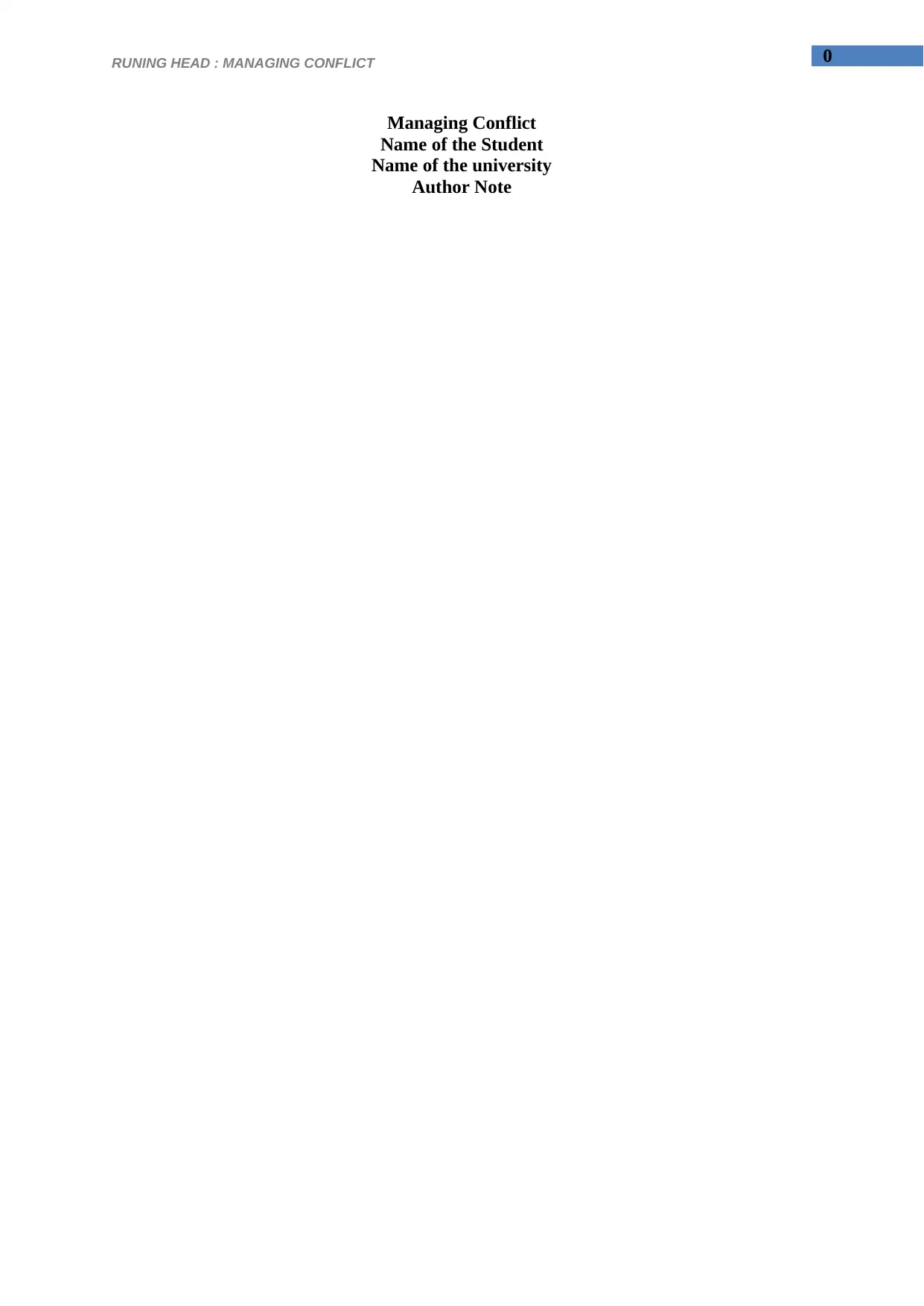
0RUNING HEAD : MANAGING CONFLICT
Managing Conflict
Name of the Student
Name of the university
Author Note
Managing Conflict
Name of the Student
Name of the university
Author Note
Secure Best Marks with AI Grader
Need help grading? Try our AI Grader for instant feedback on your assignments.
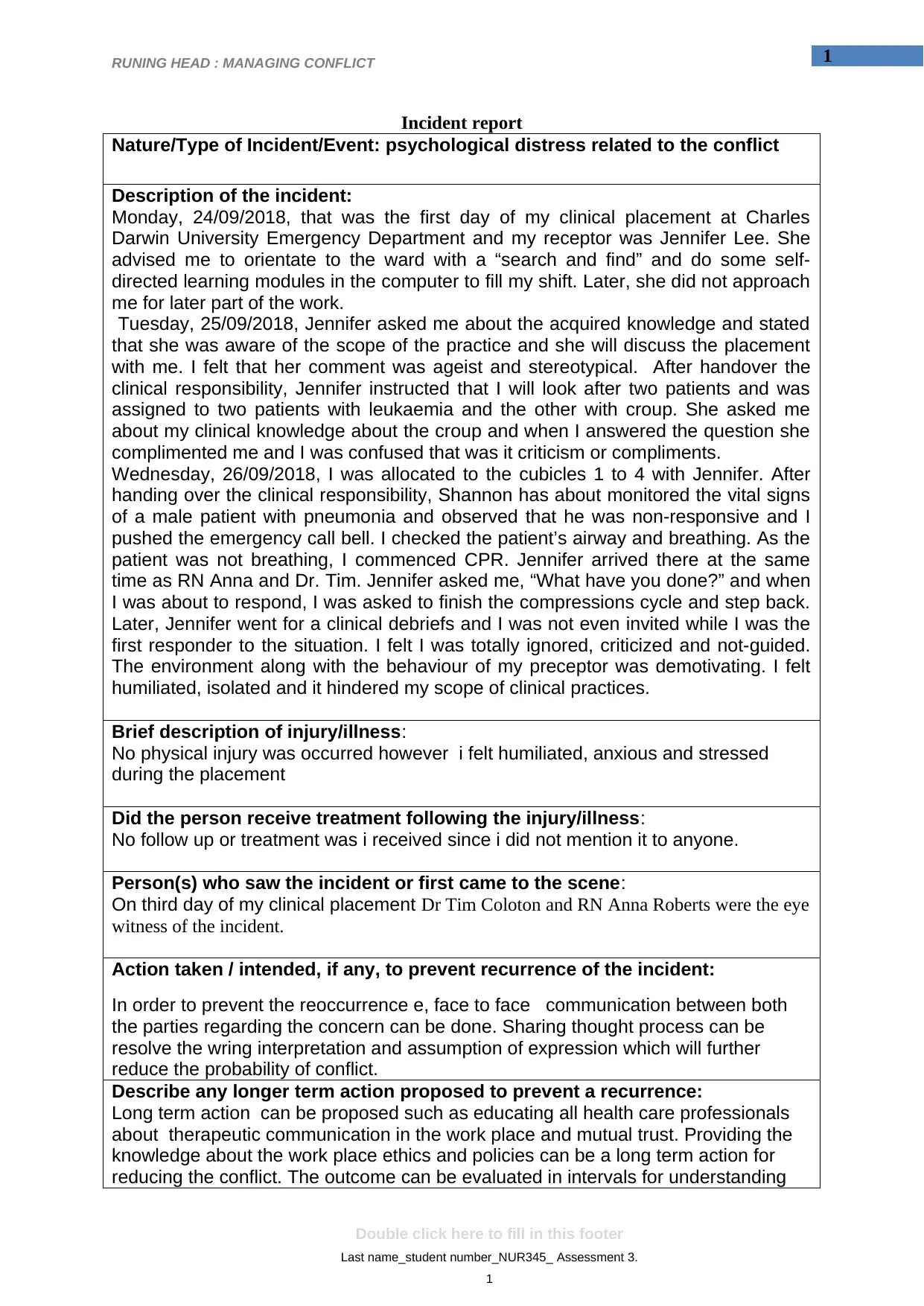
1RUNING HEAD : MANAGING CONFLICT
Incident report
Nature/Type of Incident/Event: psychological distress related to the conflict
Description of the incident:
Monday, 24/09/2018, that was the first day of my clinical placement at Charles
Darwin University Emergency Department and my receptor was Jennifer Lee. She
advised me to orientate to the ward with a “search and find” and do some self-
directed learning modules in the computer to fill my shift. Later, she did not approach
me for later part of the work.
Tuesday, 25/09/2018, Jennifer asked me about the acquired knowledge and stated
that she was aware of the scope of the practice and she will discuss the placement
with me. I felt that her comment was ageist and stereotypical. After handover the
clinical responsibility, Jennifer instructed that I will look after two patients and was
assigned to two patients with leukaemia and the other with croup. She asked me
about my clinical knowledge about the croup and when I answered the question she
complimented me and I was confused that was it criticism or compliments.
Wednesday, 26/09/2018, I was allocated to the cubicles 1 to 4 with Jennifer. After
handing over the clinical responsibility, Shannon has about monitored the vital signs
of a male patient with pneumonia and observed that he was non-responsive and I
pushed the emergency call bell. I checked the patient’s airway and breathing. As the
patient was not breathing, I commenced CPR. Jennifer arrived there at the same
time as RN Anna and Dr. Tim. Jennifer asked me, “What have you done?” and when
I was about to respond, I was asked to finish the compressions cycle and step back.
Later, Jennifer went for a clinical debriefs and I was not even invited while I was the
first responder to the situation. I felt I was totally ignored, criticized and not-guided.
The environment along with the behaviour of my preceptor was demotivating. I felt
humiliated, isolated and it hindered my scope of clinical practices.
Brief description of injury/illness:
No physical injury was occurred however i felt humiliated, anxious and stressed
during the placement
Did the person receive treatment following the injury/illness:
No follow up or treatment was i received since i did not mention it to anyone.
Person(s) who saw the incident or first came to the scene:
On third day of my clinical placement Dr Tim Coloton and RN Anna Roberts were the eye
witness of the incident.
Action taken / intended, if any, to prevent recurrence of the incident:
In order to prevent the reoccurrence e, face to face communication between both
the parties regarding the concern can be done. Sharing thought process can be
resolve the wring interpretation and assumption of expression which will further
reduce the probability of conflict.
Describe any longer term action proposed to prevent a recurrence:
Long term action can be proposed such as educating all health care professionals
about therapeutic communication in the work place and mutual trust. Providing the
knowledge about the work place ethics and policies can be a long term action for
reducing the conflict. The outcome can be evaluated in intervals for understanding
Double click here to fill in this footer
Last name_student number_NUR345_ Assessment 3.
1
Incident report
Nature/Type of Incident/Event: psychological distress related to the conflict
Description of the incident:
Monday, 24/09/2018, that was the first day of my clinical placement at Charles
Darwin University Emergency Department and my receptor was Jennifer Lee. She
advised me to orientate to the ward with a “search and find” and do some self-
directed learning modules in the computer to fill my shift. Later, she did not approach
me for later part of the work.
Tuesday, 25/09/2018, Jennifer asked me about the acquired knowledge and stated
that she was aware of the scope of the practice and she will discuss the placement
with me. I felt that her comment was ageist and stereotypical. After handover the
clinical responsibility, Jennifer instructed that I will look after two patients and was
assigned to two patients with leukaemia and the other with croup. She asked me
about my clinical knowledge about the croup and when I answered the question she
complimented me and I was confused that was it criticism or compliments.
Wednesday, 26/09/2018, I was allocated to the cubicles 1 to 4 with Jennifer. After
handing over the clinical responsibility, Shannon has about monitored the vital signs
of a male patient with pneumonia and observed that he was non-responsive and I
pushed the emergency call bell. I checked the patient’s airway and breathing. As the
patient was not breathing, I commenced CPR. Jennifer arrived there at the same
time as RN Anna and Dr. Tim. Jennifer asked me, “What have you done?” and when
I was about to respond, I was asked to finish the compressions cycle and step back.
Later, Jennifer went for a clinical debriefs and I was not even invited while I was the
first responder to the situation. I felt I was totally ignored, criticized and not-guided.
The environment along with the behaviour of my preceptor was demotivating. I felt
humiliated, isolated and it hindered my scope of clinical practices.
Brief description of injury/illness:
No physical injury was occurred however i felt humiliated, anxious and stressed
during the placement
Did the person receive treatment following the injury/illness:
No follow up or treatment was i received since i did not mention it to anyone.
Person(s) who saw the incident or first came to the scene:
On third day of my clinical placement Dr Tim Coloton and RN Anna Roberts were the eye
witness of the incident.
Action taken / intended, if any, to prevent recurrence of the incident:
In order to prevent the reoccurrence e, face to face communication between both
the parties regarding the concern can be done. Sharing thought process can be
resolve the wring interpretation and assumption of expression which will further
reduce the probability of conflict.
Describe any longer term action proposed to prevent a recurrence:
Long term action can be proposed such as educating all health care professionals
about therapeutic communication in the work place and mutual trust. Providing the
knowledge about the work place ethics and policies can be a long term action for
reducing the conflict. The outcome can be evaluated in intervals for understanding
Double click here to fill in this footer
Last name_student number_NUR345_ Assessment 3.
1
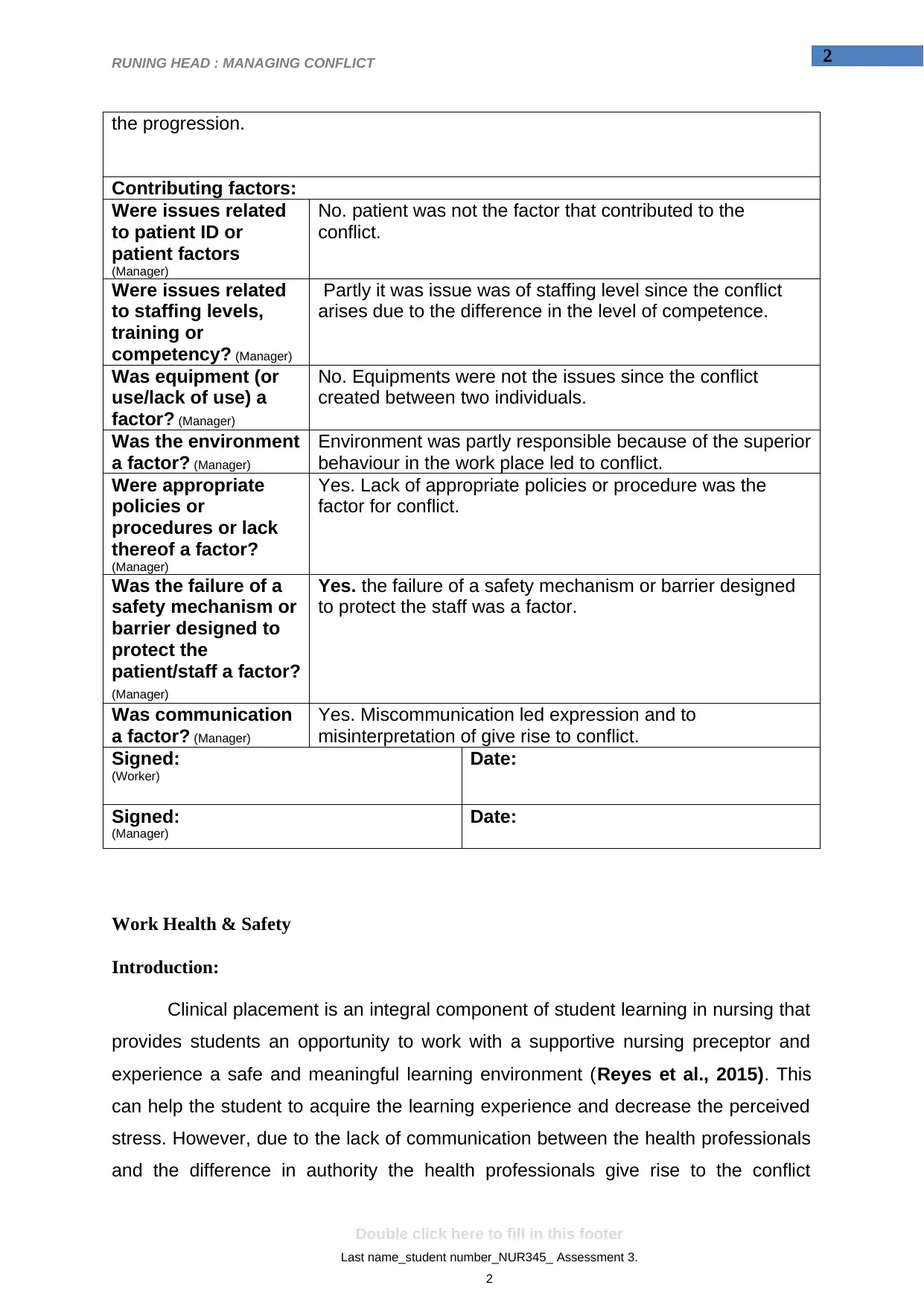
2RUNING HEAD : MANAGING CONFLICT
the progression.
Contributing factors:
Were issues related
to patient ID or
patient factors
(Manager)
No. patient was not the factor that contributed to the
conflict.
Were issues related
to staffing levels,
training or
competency? (Manager)
Partly it was issue was of staffing level since the conflict
arises due to the difference in the level of competence.
Was equipment (or
use/lack of use) a
factor? (Manager)
No. Equipments were not the issues since the conflict
created between two individuals.
Was the environment
a factor? (Manager)
Environment was partly responsible because of the superior
behaviour in the work place led to conflict.
Were appropriate
policies or
procedures or lack
thereof a factor?
(Manager)
Yes. Lack of appropriate policies or procedure was the
factor for conflict.
Was the failure of a
safety mechanism or
barrier designed to
protect the
patient/staff a factor?
(Manager)
Yes. the failure of a safety mechanism or barrier designed
to protect the staff was a factor.
Was communication
a factor? (Manager)
Yes. Miscommunication led expression and to
misinterpretation of give rise to conflict.
Signed:
(Worker)
Date:
Signed:
(Manager)
Date:
Work Health & Safety
Introduction:
Clinical placement is an integral component of student learning in nursing that
provides students an opportunity to work with a supportive nursing preceptor and
experience a safe and meaningful learning environment (Reyes et al., 2015). This
can help the student to acquire the learning experience and decrease the perceived
stress. However, due to the lack of communication between the health professionals
and the difference in authority the health professionals give rise to the conflict
Double click here to fill in this footer
Last name_student number_NUR345_ Assessment 3.
2
the progression.
Contributing factors:
Were issues related
to patient ID or
patient factors
(Manager)
No. patient was not the factor that contributed to the
conflict.
Were issues related
to staffing levels,
training or
competency? (Manager)
Partly it was issue was of staffing level since the conflict
arises due to the difference in the level of competence.
Was equipment (or
use/lack of use) a
factor? (Manager)
No. Equipments were not the issues since the conflict
created between two individuals.
Was the environment
a factor? (Manager)
Environment was partly responsible because of the superior
behaviour in the work place led to conflict.
Were appropriate
policies or
procedures or lack
thereof a factor?
(Manager)
Yes. Lack of appropriate policies or procedure was the
factor for conflict.
Was the failure of a
safety mechanism or
barrier designed to
protect the
patient/staff a factor?
(Manager)
Yes. the failure of a safety mechanism or barrier designed
to protect the staff was a factor.
Was communication
a factor? (Manager)
Yes. Miscommunication led expression and to
misinterpretation of give rise to conflict.
Signed:
(Worker)
Date:
Signed:
(Manager)
Date:
Work Health & Safety
Introduction:
Clinical placement is an integral component of student learning in nursing that
provides students an opportunity to work with a supportive nursing preceptor and
experience a safe and meaningful learning environment (Reyes et al., 2015). This
can help the student to acquire the learning experience and decrease the perceived
stress. However, due to the lack of communication between the health professionals
and the difference in authority the health professionals give rise to the conflict
Double click here to fill in this footer
Last name_student number_NUR345_ Assessment 3.
2
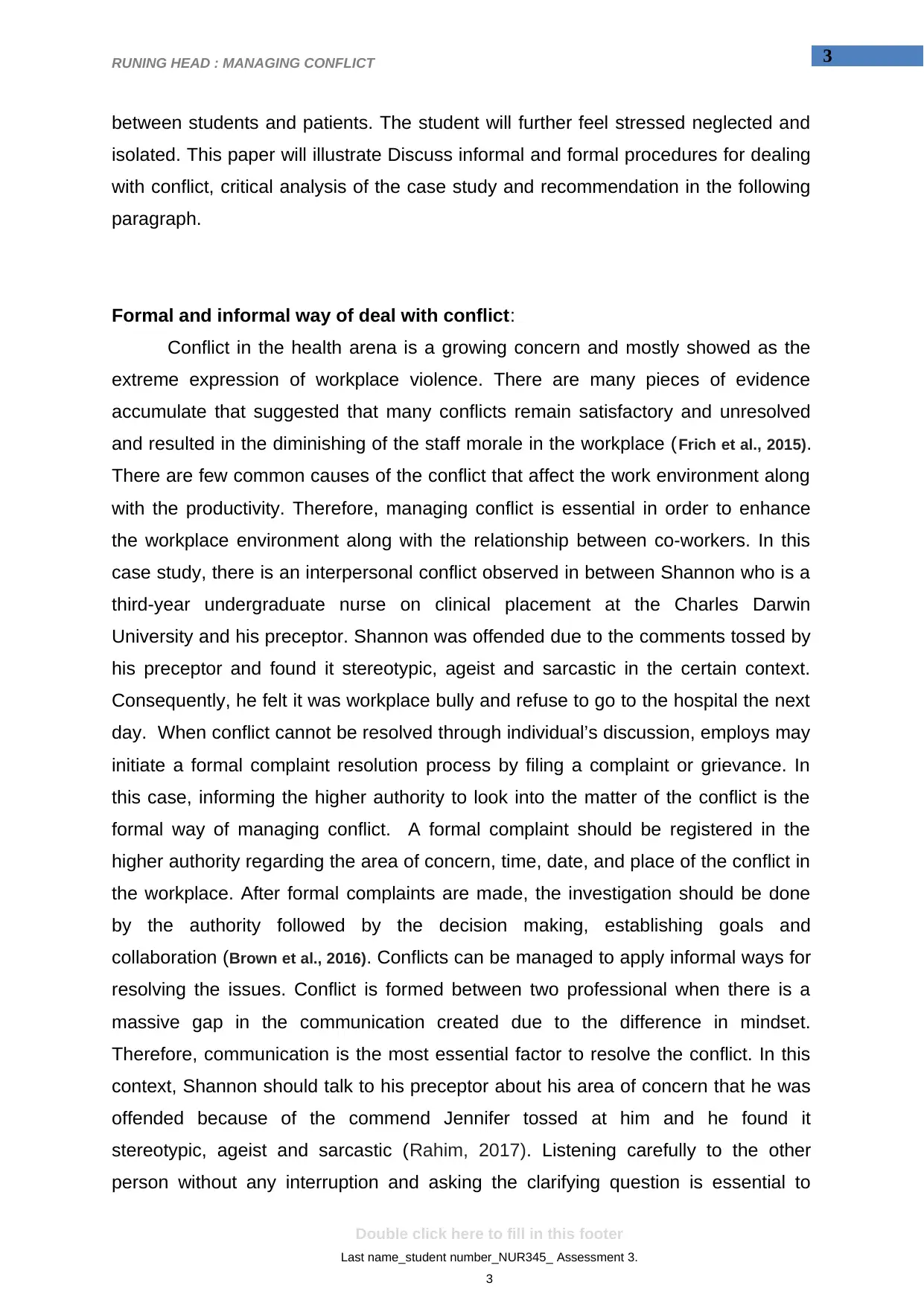
3RUNING HEAD : MANAGING CONFLICT
between students and patients. The student will further feel stressed neglected and
isolated. This paper will illustrate Discuss informal and formal procedures for dealing
with conflict, critical analysis of the case study and recommendation in the following
paragraph.
Formal and informal way of deal with conflict:
Conflict in the health arena is a growing concern and mostly showed as the
extreme expression of workplace violence. There are many pieces of evidence
accumulate that suggested that many conflicts remain satisfactory and unresolved
and resulted in the diminishing of the staff morale in the workplace (Frich et al., 2015).
There are few common causes of the conflict that affect the work environment along
with the productivity. Therefore, managing conflict is essential in order to enhance
the workplace environment along with the relationship between co-workers. In this
case study, there is an interpersonal conflict observed in between Shannon who is a
third-year undergraduate nurse on clinical placement at the Charles Darwin
University and his preceptor. Shannon was offended due to the comments tossed by
his preceptor and found it stereotypic, ageist and sarcastic in the certain context.
Consequently, he felt it was workplace bully and refuse to go to the hospital the next
day. When conflict cannot be resolved through individual’s discussion, employs may
initiate a formal complaint resolution process by filing a complaint or grievance. In
this case, informing the higher authority to look into the matter of the conflict is the
formal way of managing conflict. A formal complaint should be registered in the
higher authority regarding the area of concern, time, date, and place of the conflict in
the workplace. After formal complaints are made, the investigation should be done
by the authority followed by the decision making, establishing goals and
collaboration (Brown et al., 2016). Conflicts can be managed to apply informal ways for
resolving the issues. Conflict is formed between two professional when there is a
massive gap in the communication created due to the difference in mindset.
Therefore, communication is the most essential factor to resolve the conflict. In this
context, Shannon should talk to his preceptor about his area of concern that he was
offended because of the commend Jennifer tossed at him and he found it
stereotypic, ageist and sarcastic (Rahim, 2017). Listening carefully to the other
person without any interruption and asking the clarifying question is essential to
Double click here to fill in this footer
Last name_student number_NUR345_ Assessment 3.
3
between students and patients. The student will further feel stressed neglected and
isolated. This paper will illustrate Discuss informal and formal procedures for dealing
with conflict, critical analysis of the case study and recommendation in the following
paragraph.
Formal and informal way of deal with conflict:
Conflict in the health arena is a growing concern and mostly showed as the
extreme expression of workplace violence. There are many pieces of evidence
accumulate that suggested that many conflicts remain satisfactory and unresolved
and resulted in the diminishing of the staff morale in the workplace (Frich et al., 2015).
There are few common causes of the conflict that affect the work environment along
with the productivity. Therefore, managing conflict is essential in order to enhance
the workplace environment along with the relationship between co-workers. In this
case study, there is an interpersonal conflict observed in between Shannon who is a
third-year undergraduate nurse on clinical placement at the Charles Darwin
University and his preceptor. Shannon was offended due to the comments tossed by
his preceptor and found it stereotypic, ageist and sarcastic in the certain context.
Consequently, he felt it was workplace bully and refuse to go to the hospital the next
day. When conflict cannot be resolved through individual’s discussion, employs may
initiate a formal complaint resolution process by filing a complaint or grievance. In
this case, informing the higher authority to look into the matter of the conflict is the
formal way of managing conflict. A formal complaint should be registered in the
higher authority regarding the area of concern, time, date, and place of the conflict in
the workplace. After formal complaints are made, the investigation should be done
by the authority followed by the decision making, establishing goals and
collaboration (Brown et al., 2016). Conflicts can be managed to apply informal ways for
resolving the issues. Conflict is formed between two professional when there is a
massive gap in the communication created due to the difference in mindset.
Therefore, communication is the most essential factor to resolve the conflict. In this
context, Shannon should talk to his preceptor about his area of concern that he was
offended because of the commend Jennifer tossed at him and he found it
stereotypic, ageist and sarcastic (Rahim, 2017). Listening carefully to the other
person without any interruption and asking the clarifying question is essential to
Double click here to fill in this footer
Last name_student number_NUR345_ Assessment 3.
3
Secure Best Marks with AI Grader
Need help grading? Try our AI Grader for instant feedback on your assignments.

4RUNING HEAD : MANAGING CONFLICT
reduce the conflict between to health professionals. In order to manage the conflict,
identification of the area where both agrees and disagrees should be done. Follow
up plan should be designed where both the individual will share their thought
process, looking for opportunities to make progress for managing the conflict in the
workplace (Brown et al., 2016).This will further build a healthy relationship in the
workplace between health professionals, resolve the communication gap between
professionals, reduce the stereotypic concepts of both the individuals and enhance
productivity along with the success of individuals.
Critical analysis of the case study:
This case study represents the professional conflict between third-year
undergraduate student Shannon Doe and his preceptor Jennifer Lee at the
emergency department of Charles Darwin university hospital. In the first day of the
placement, due to poor skills and a shortage of the staffs, his preceptor offered him
to work with her for a limited period of the time, only for the first shift. She instructed
him to work through the self-directed learning modules on the infection, WHS,
mandatory reporting and aggression. In the clinical placement of emergency room,
she should acquire the holistic knowledge regarding medical practices instead he
acquires knowledge in certain clinical areas for a limited period of time. Therefore,
poor clarity of the role of the preceptor and misunderstanding by the student
observed which further led to the mental conflict (Wallensteen, 2015).
In the second day, Jennifer asked him about the acquired knowledge of
Shannon and stated that she was aware of the scope of the practice and she will
discuss the placement with Shannon. Shannon found the comment of her ageist and
stereotypic. After handover the clinical responsibility, Jennifer instructed that she will
look after two patients, bed number has a patient of leukemia where she asked
Shannon about the clinical assessment and after answering that she complimented
him. The complement of the Jennifer was sarcastic according to the mindset of
Shannon. Here, interpersonal conflict arises between two professional individuals.
This occurs typically because of wrong interpretation of expression, the varied
mental makeup of two different individuals associated with the previous adverse
experiences (Thomas, 2017). Later, during the assessment of next patient who was
suffering from croup, Jennifer asked him about the disease and interrupted him by
Double click here to fill in this footer
Last name_student number_NUR345_ Assessment 3.
4
reduce the conflict between to health professionals. In order to manage the conflict,
identification of the area where both agrees and disagrees should be done. Follow
up plan should be designed where both the individual will share their thought
process, looking for opportunities to make progress for managing the conflict in the
workplace (Brown et al., 2016).This will further build a healthy relationship in the
workplace between health professionals, resolve the communication gap between
professionals, reduce the stereotypic concepts of both the individuals and enhance
productivity along with the success of individuals.
Critical analysis of the case study:
This case study represents the professional conflict between third-year
undergraduate student Shannon Doe and his preceptor Jennifer Lee at the
emergency department of Charles Darwin university hospital. In the first day of the
placement, due to poor skills and a shortage of the staffs, his preceptor offered him
to work with her for a limited period of the time, only for the first shift. She instructed
him to work through the self-directed learning modules on the infection, WHS,
mandatory reporting and aggression. In the clinical placement of emergency room,
she should acquire the holistic knowledge regarding medical practices instead he
acquires knowledge in certain clinical areas for a limited period of time. Therefore,
poor clarity of the role of the preceptor and misunderstanding by the student
observed which further led to the mental conflict (Wallensteen, 2015).
In the second day, Jennifer asked him about the acquired knowledge of
Shannon and stated that she was aware of the scope of the practice and she will
discuss the placement with Shannon. Shannon found the comment of her ageist and
stereotypic. After handover the clinical responsibility, Jennifer instructed that she will
look after two patients, bed number has a patient of leukemia where she asked
Shannon about the clinical assessment and after answering that she complimented
him. The complement of the Jennifer was sarcastic according to the mindset of
Shannon. Here, interpersonal conflict arises between two professional individuals.
This occurs typically because of wrong interpretation of expression, the varied
mental makeup of two different individuals associated with the previous adverse
experiences (Thomas, 2017). Later, during the assessment of next patient who was
suffering from croup, Jennifer asked him about the disease and interrupted him by
Double click here to fill in this footer
Last name_student number_NUR345_ Assessment 3.
4

5RUNING HEAD : MANAGING CONFLICT
the instruction to take care of other things. He felt dismissed and prioritized clinical
needs over the clinical education. Here, the behaviour of Jennifer reflects her
judgmental and stereotypic mentality towards Shannon. Moreover, the knowledge of
clinical practices of Shannon was interrupted which is an ethical violence in clinical
premises since it hinders the accomplishment of the nursing goal (Martyn, Zanella &
Wilkinson, 2017)..
In the third day, Jennifer and Shannon are allocated to the cubicles 1 to 4.after
handing over the clinical responsibility, Shannon has about monitored the vital signs
of a male patient with pneumonia and observed that he was non-responsive. After
repetitive medical incidence, Jennifer dismissed her from the further responsibilities
and did not invite her for Debrief which was a good learning opportunity for Shannon;
however, she was excluded and ignored that has an adverse effect on the student.
Denied learning opportunities, ignored and exclusion are the form of bully that can
be solved by proper communication ( Folger, Poole ,& Stutman, 2017). .
The next day Shannon called the nursing unit manager and informed him that she
could not come referring to the behaviour of Jennifer as the bully. Here, she felt
offended after repetitive events of adverse experiences.
The recommendation to foster Shannon’s resilience in future placement:
The case study represents the professional conflict between third-year
undergraduate student Shannon Doe and his preceptor Jennifer lee which hinders
the scope of clinical practice in clinical practices. In order to regulate the nursing
practices, nursing and midwifery board of Australia set the specific standard that
enhances the placement procedure for nurses and helps to place the nurses who
acquire excellent clinical skills to quire the patient-centric care. In the context of the
case study, where an interpersonal conflict between two professionals disrupts the
workplace stability, the standards help her to cope up with the workplace difficulties.
According to Adrian & Chiarella, (2015)., the standard 2 can aid her in overcoming
the difficulties for the future placement. Standard 2 suggests the engagement of
both the parties in a therapeutic and professional relationship in clinical premises. It
Double click here to fill in this footer
Last name_student number_NUR345_ Assessment 3.
5
the instruction to take care of other things. He felt dismissed and prioritized clinical
needs over the clinical education. Here, the behaviour of Jennifer reflects her
judgmental and stereotypic mentality towards Shannon. Moreover, the knowledge of
clinical practices of Shannon was interrupted which is an ethical violence in clinical
premises since it hinders the accomplishment of the nursing goal (Martyn, Zanella &
Wilkinson, 2017)..
In the third day, Jennifer and Shannon are allocated to the cubicles 1 to 4.after
handing over the clinical responsibility, Shannon has about monitored the vital signs
of a male patient with pneumonia and observed that he was non-responsive. After
repetitive medical incidence, Jennifer dismissed her from the further responsibilities
and did not invite her for Debrief which was a good learning opportunity for Shannon;
however, she was excluded and ignored that has an adverse effect on the student.
Denied learning opportunities, ignored and exclusion are the form of bully that can
be solved by proper communication ( Folger, Poole ,& Stutman, 2017). .
The next day Shannon called the nursing unit manager and informed him that she
could not come referring to the behaviour of Jennifer as the bully. Here, she felt
offended after repetitive events of adverse experiences.
The recommendation to foster Shannon’s resilience in future placement:
The case study represents the professional conflict between third-year
undergraduate student Shannon Doe and his preceptor Jennifer lee which hinders
the scope of clinical practice in clinical practices. In order to regulate the nursing
practices, nursing and midwifery board of Australia set the specific standard that
enhances the placement procedure for nurses and helps to place the nurses who
acquire excellent clinical skills to quire the patient-centric care. In the context of the
case study, where an interpersonal conflict between two professionals disrupts the
workplace stability, the standards help her to cope up with the workplace difficulties.
According to Adrian & Chiarella, (2015)., the standard 2 can aid her in overcoming
the difficulties for the future placement. Standard 2 suggests the engagement of
both the parties in a therapeutic and professional relationship in clinical premises. It
Double click here to fill in this footer
Last name_student number_NUR345_ Assessment 3.
5
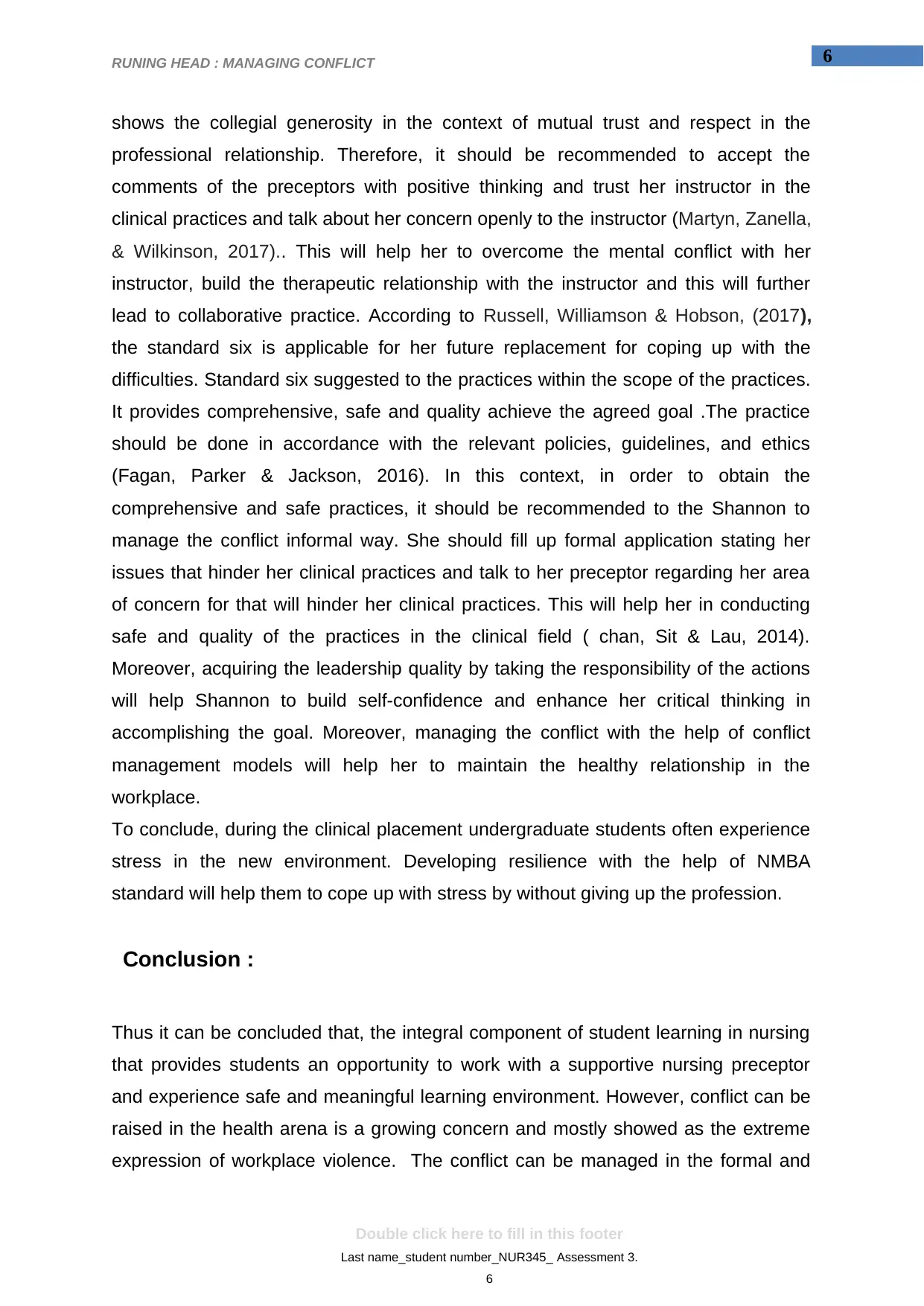
6RUNING HEAD : MANAGING CONFLICT
shows the collegial generosity in the context of mutual trust and respect in the
professional relationship. Therefore, it should be recommended to accept the
comments of the preceptors with positive thinking and trust her instructor in the
clinical practices and talk about her concern openly to the instructor (Martyn, Zanella,
& Wilkinson, 2017).. This will help her to overcome the mental conflict with her
instructor, build the therapeutic relationship with the instructor and this will further
lead to collaborative practice. According to Russell, Williamson & Hobson, (2017),
the standard six is applicable for her future replacement for coping up with the
difficulties. Standard six suggested to the practices within the scope of the practices.
It provides comprehensive, safe and quality achieve the agreed goal .The practice
should be done in accordance with the relevant policies, guidelines, and ethics
(Fagan, Parker & Jackson, 2016). In this context, in order to obtain the
comprehensive and safe practices, it should be recommended to the Shannon to
manage the conflict informal way. She should fill up formal application stating her
issues that hinder her clinical practices and talk to her preceptor regarding her area
of concern for that will hinder her clinical practices. This will help her in conducting
safe and quality of the practices in the clinical field ( chan, Sit & Lau, 2014).
Moreover, acquiring the leadership quality by taking the responsibility of the actions
will help Shannon to build self-confidence and enhance her critical thinking in
accomplishing the goal. Moreover, managing the conflict with the help of conflict
management models will help her to maintain the healthy relationship in the
workplace.
To conclude, during the clinical placement undergraduate students often experience
stress in the new environment. Developing resilience with the help of NMBA
standard will help them to cope up with stress by without giving up the profession.
Conclusion :
Thus it can be concluded that, the integral component of student learning in nursing
that provides students an opportunity to work with a supportive nursing preceptor
and experience safe and meaningful learning environment. However, conflict can be
raised in the health arena is a growing concern and mostly showed as the extreme
expression of workplace violence. The conflict can be managed in the formal and
Double click here to fill in this footer
Last name_student number_NUR345_ Assessment 3.
6
shows the collegial generosity in the context of mutual trust and respect in the
professional relationship. Therefore, it should be recommended to accept the
comments of the preceptors with positive thinking and trust her instructor in the
clinical practices and talk about her concern openly to the instructor (Martyn, Zanella,
& Wilkinson, 2017).. This will help her to overcome the mental conflict with her
instructor, build the therapeutic relationship with the instructor and this will further
lead to collaborative practice. According to Russell, Williamson & Hobson, (2017),
the standard six is applicable for her future replacement for coping up with the
difficulties. Standard six suggested to the practices within the scope of the practices.
It provides comprehensive, safe and quality achieve the agreed goal .The practice
should be done in accordance with the relevant policies, guidelines, and ethics
(Fagan, Parker & Jackson, 2016). In this context, in order to obtain the
comprehensive and safe practices, it should be recommended to the Shannon to
manage the conflict informal way. She should fill up formal application stating her
issues that hinder her clinical practices and talk to her preceptor regarding her area
of concern for that will hinder her clinical practices. This will help her in conducting
safe and quality of the practices in the clinical field ( chan, Sit & Lau, 2014).
Moreover, acquiring the leadership quality by taking the responsibility of the actions
will help Shannon to build self-confidence and enhance her critical thinking in
accomplishing the goal. Moreover, managing the conflict with the help of conflict
management models will help her to maintain the healthy relationship in the
workplace.
To conclude, during the clinical placement undergraduate students often experience
stress in the new environment. Developing resilience with the help of NMBA
standard will help them to cope up with stress by without giving up the profession.
Conclusion :
Thus it can be concluded that, the integral component of student learning in nursing
that provides students an opportunity to work with a supportive nursing preceptor
and experience safe and meaningful learning environment. However, conflict can be
raised in the health arena is a growing concern and mostly showed as the extreme
expression of workplace violence. The conflict can be managed in the formal and
Double click here to fill in this footer
Last name_student number_NUR345_ Assessment 3.
6
Paraphrase This Document
Need a fresh take? Get an instant paraphrase of this document with our AI Paraphraser
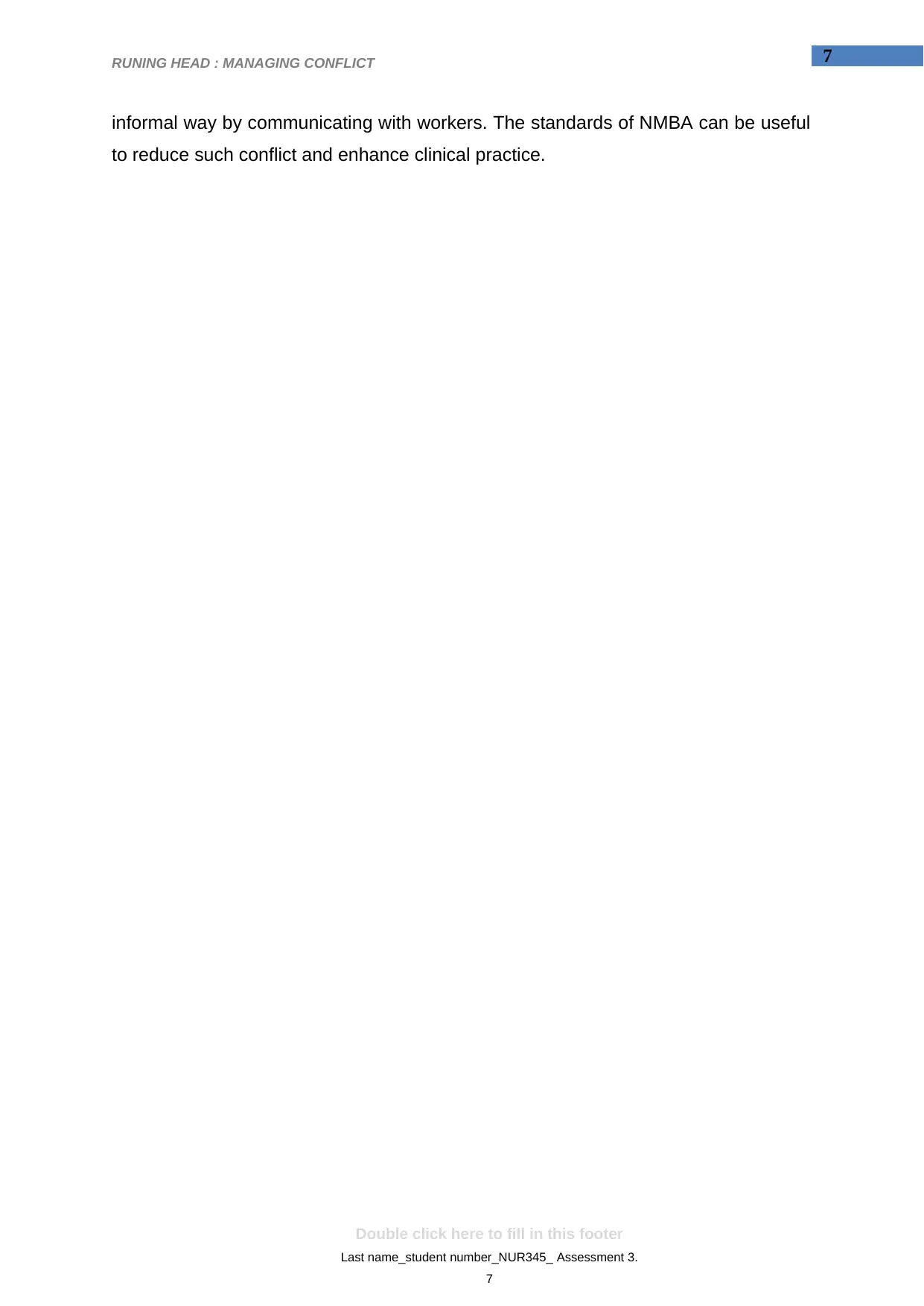
7RUNING HEAD : MANAGING CONFLICT
informal way by communicating with workers. The standards of NMBA can be useful
to reduce such conflict and enhance clinical practice.
Double click here to fill in this footer
Last name_student number_NUR345_ Assessment 3.
7
informal way by communicating with workers. The standards of NMBA can be useful
to reduce such conflict and enhance clinical practice.
Double click here to fill in this footer
Last name_student number_NUR345_ Assessment 3.
7
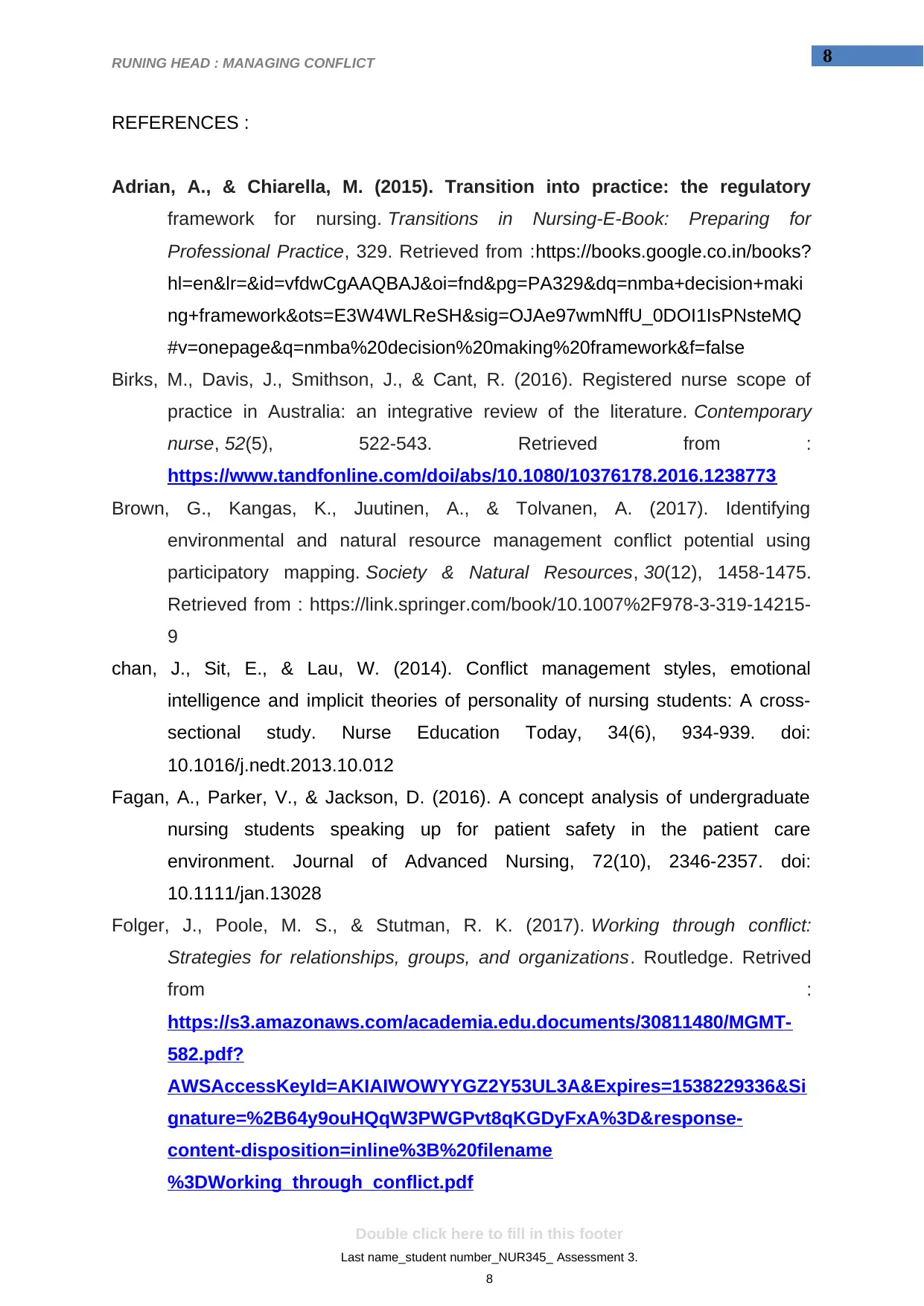
8RUNING HEAD : MANAGING CONFLICT
REFERENCES :
Adrian, A., & Chiarella, M. (2015). Transition into practice: the regulatory
framework for nursing. Transitions in Nursing-E-Book: Preparing for
Professional Practice, 329. Retrieved from :https://books.google.co.in/books?
hl=en&lr=&id=vfdwCgAAQBAJ&oi=fnd&pg=PA329&dq=nmba+decision+maki
ng+framework&ots=E3W4WLReSH&sig=OJAe97wmNffU_0DOI1IsPNsteMQ
#v=onepage&q=nmba%20decision%20making%20framework&f=false
Birks, M., Davis, J., Smithson, J., & Cant, R. (2016). Registered nurse scope of
practice in Australia: an integrative review of the literature. Contemporary
nurse, 52(5), 522-543. Retrieved from :
https://www.tandfonline.com/doi/abs/10.1080/10376178.2016.1238773
Brown, G., Kangas, K., Juutinen, A., & Tolvanen, A. (2017). Identifying
environmental and natural resource management conflict potential using
participatory mapping. Society & Natural Resources, 30(12), 1458-1475.
Retrieved from : https://link.springer.com/book/10.1007%2F978-3-319-14215-
9
chan, J., Sit, E., & Lau, W. (2014). Conflict management styles, emotional
intelligence and implicit theories of personality of nursing students: A cross-
sectional study. Nurse Education Today, 34(6), 934-939. doi:
10.1016/j.nedt.2013.10.012
Fagan, A., Parker, V., & Jackson, D. (2016). A concept analysis of undergraduate
nursing students speaking up for patient safety in the patient care
environment. Journal of Advanced Nursing, 72(10), 2346-2357. doi:
10.1111/jan.13028
Folger, J., Poole, M. S., & Stutman, R. K. (2017). Working through conflict:
Strategies for relationships, groups, and organizations. Routledge. Retrived
from :
https://s3.amazonaws.com/academia.edu.documents/30811480/MGMT-
582.pdf?
AWSAccessKeyId=AKIAIWOWYYGZ2Y53UL3A&Expires=1538229336&Si
gnature=%2B64y9ouHQqW3PWGPvt8qKGDyFxA%3D&response-
content-disposition=inline%3B%20filename
%3DWorking_through_conflict.pdf
Double click here to fill in this footer
Last name_student number_NUR345_ Assessment 3.
8
REFERENCES :
Adrian, A., & Chiarella, M. (2015). Transition into practice: the regulatory
framework for nursing. Transitions in Nursing-E-Book: Preparing for
Professional Practice, 329. Retrieved from :https://books.google.co.in/books?
hl=en&lr=&id=vfdwCgAAQBAJ&oi=fnd&pg=PA329&dq=nmba+decision+maki
ng+framework&ots=E3W4WLReSH&sig=OJAe97wmNffU_0DOI1IsPNsteMQ
#v=onepage&q=nmba%20decision%20making%20framework&f=false
Birks, M., Davis, J., Smithson, J., & Cant, R. (2016). Registered nurse scope of
practice in Australia: an integrative review of the literature. Contemporary
nurse, 52(5), 522-543. Retrieved from :
https://www.tandfonline.com/doi/abs/10.1080/10376178.2016.1238773
Brown, G., Kangas, K., Juutinen, A., & Tolvanen, A. (2017). Identifying
environmental and natural resource management conflict potential using
participatory mapping. Society & Natural Resources, 30(12), 1458-1475.
Retrieved from : https://link.springer.com/book/10.1007%2F978-3-319-14215-
9
chan, J., Sit, E., & Lau, W. (2014). Conflict management styles, emotional
intelligence and implicit theories of personality of nursing students: A cross-
sectional study. Nurse Education Today, 34(6), 934-939. doi:
10.1016/j.nedt.2013.10.012
Fagan, A., Parker, V., & Jackson, D. (2016). A concept analysis of undergraduate
nursing students speaking up for patient safety in the patient care
environment. Journal of Advanced Nursing, 72(10), 2346-2357. doi:
10.1111/jan.13028
Folger, J., Poole, M. S., & Stutman, R. K. (2017). Working through conflict:
Strategies for relationships, groups, and organizations. Routledge. Retrived
from :
https://s3.amazonaws.com/academia.edu.documents/30811480/MGMT-
582.pdf?
AWSAccessKeyId=AKIAIWOWYYGZ2Y53UL3A&Expires=1538229336&Si
gnature=%2B64y9ouHQqW3PWGPvt8qKGDyFxA%3D&response-
content-disposition=inline%3B%20filename
%3DWorking_through_conflict.pdf
Double click here to fill in this footer
Last name_student number_NUR345_ Assessment 3.
8

9RUNING HEAD : MANAGING CONFLICT
Frich, J. C., Brewster, A. L., Cherlin, E. J., & Bradley, E. H. (2015). Leadership
development programs for physicians: a systematic review. Journal of general
internal medicine, 30(5), 656-674. DOI: 10.1002/cncy.21544,
wileyonlinelibrary.com
Martyn, J. A., Zanella, S., & Wilkinson, A. (2017). Perspectives from practice:
complexities of personal care workers’ education, regulation and
practice. Australian Health Review. Retrieved from :
https://books.google.co.in/books?
hl=en&lr=&id=vfdwCgAAQBAJ&oi=fnd&pg=PA329&dq=nmba+decision+maki
ng+framework&ots=E3W4WLReSH&sig=OJAe97wmNffU_0DOI1IsPNsteMQ
#v=onepage&q=nmba%20decision%20making%20framework&f=false
Rahim, M. A. (2017). Managing conflict in organizations. Routledge. Retrived
fo :https://www.taylorfrancis.com/books/9781351507288. Retrieved from ;
http://pdfsifreecom.com/conflict-practices-in-management-settlement-and-
resolution-virtual-catalog-free-pdf-ebooks.pdf
Reyes, A. T., Andrusyszyn, M. A., Iwasiw, C., Forchuk, C., & Babenko-Mould, Y.
(2015). Nursing students' understanding and enactment of resilience: A
grounded theory study. Journal of Advanced Nursing, 71(11), 2622-2633. dio:
10.1111/jan.12730
Russell, K., Williamson, S., & Hobson, A. (2017). The art of clinical supervision: The
traffic light system for the delegation of care. Australian Journal of Advanced
Nursing, The, 35(1), 33. Retrieved from :
http://www.ajan.com.au/Vol35/Issue1/4Russell.pdf
Thomas, K. W. (2017). Conflict and conflict management: Reflections and
update. Journal of organizational behavior, 13(3), 265-274.
https://onlinelibrary.wiley.com/doi/abs/10.1002/job.4030130307
Trede, Sutton, & Bernoth. (2016). Conceptualisations and perceptions of the nurse
preceptor's role: A scoping review. Nurse Education Today, 36, 268-274. dio:
10.1016/j.nedt.2015.07.032
Ury, W. L., Brett, J. M., & Goldberg, S. B. (2017).Getting disputes resolved:
Designing systems to cut the costs of conflict. Jossey-Bass. Retrived from :
https://books.google.co.in/books?
hl=en&lr=&id=wvqICwAAQBAJ&oi=fnd&pg=PP1&dq=management+conflict+r
esolution+strategies&ots=jyLrBFPscy&sig=0s4Ws3HcJKLHoSWeArdjRSmP7
Double click here to fill in this footer
Last name_student number_NUR345_ Assessment 3.
9
Frich, J. C., Brewster, A. L., Cherlin, E. J., & Bradley, E. H. (2015). Leadership
development programs for physicians: a systematic review. Journal of general
internal medicine, 30(5), 656-674. DOI: 10.1002/cncy.21544,
wileyonlinelibrary.com
Martyn, J. A., Zanella, S., & Wilkinson, A. (2017). Perspectives from practice:
complexities of personal care workers’ education, regulation and
practice. Australian Health Review. Retrieved from :
https://books.google.co.in/books?
hl=en&lr=&id=vfdwCgAAQBAJ&oi=fnd&pg=PA329&dq=nmba+decision+maki
ng+framework&ots=E3W4WLReSH&sig=OJAe97wmNffU_0DOI1IsPNsteMQ
#v=onepage&q=nmba%20decision%20making%20framework&f=false
Rahim, M. A. (2017). Managing conflict in organizations. Routledge. Retrived
fo :https://www.taylorfrancis.com/books/9781351507288. Retrieved from ;
http://pdfsifreecom.com/conflict-practices-in-management-settlement-and-
resolution-virtual-catalog-free-pdf-ebooks.pdf
Reyes, A. T., Andrusyszyn, M. A., Iwasiw, C., Forchuk, C., & Babenko-Mould, Y.
(2015). Nursing students' understanding and enactment of resilience: A
grounded theory study. Journal of Advanced Nursing, 71(11), 2622-2633. dio:
10.1111/jan.12730
Russell, K., Williamson, S., & Hobson, A. (2017). The art of clinical supervision: The
traffic light system for the delegation of care. Australian Journal of Advanced
Nursing, The, 35(1), 33. Retrieved from :
http://www.ajan.com.au/Vol35/Issue1/4Russell.pdf
Thomas, K. W. (2017). Conflict and conflict management: Reflections and
update. Journal of organizational behavior, 13(3), 265-274.
https://onlinelibrary.wiley.com/doi/abs/10.1002/job.4030130307
Trede, Sutton, & Bernoth. (2016). Conceptualisations and perceptions of the nurse
preceptor's role: A scoping review. Nurse Education Today, 36, 268-274. dio:
10.1016/j.nedt.2015.07.032
Ury, W. L., Brett, J. M., & Goldberg, S. B. (2017).Getting disputes resolved:
Designing systems to cut the costs of conflict. Jossey-Bass. Retrived from :
https://books.google.co.in/books?
hl=en&lr=&id=wvqICwAAQBAJ&oi=fnd&pg=PP1&dq=management+conflict+r
esolution+strategies&ots=jyLrBFPscy&sig=0s4Ws3HcJKLHoSWeArdjRSmP7
Double click here to fill in this footer
Last name_student number_NUR345_ Assessment 3.
9
Secure Best Marks with AI Grader
Need help grading? Try our AI Grader for instant feedback on your assignments.

10RUNING HEAD : MANAGING CONFLICT
z4#v=onepage&q=management%20conflict%20resolution
%20strategies&f=false
Wallensteen, P. (2015). Understanding conflict resolution. Sage.
http://metro.cua.edu/res/docs/Fall-3-2016-Textbook-List-8-31-16-1-.pdf
Double click here to fill in this footer
Last name_student number_NUR345_ Assessment 3.
10
z4#v=onepage&q=management%20conflict%20resolution
%20strategies&f=false
Wallensteen, P. (2015). Understanding conflict resolution. Sage.
http://metro.cua.edu/res/docs/Fall-3-2016-Textbook-List-8-31-16-1-.pdf
Double click here to fill in this footer
Last name_student number_NUR345_ Assessment 3.
10
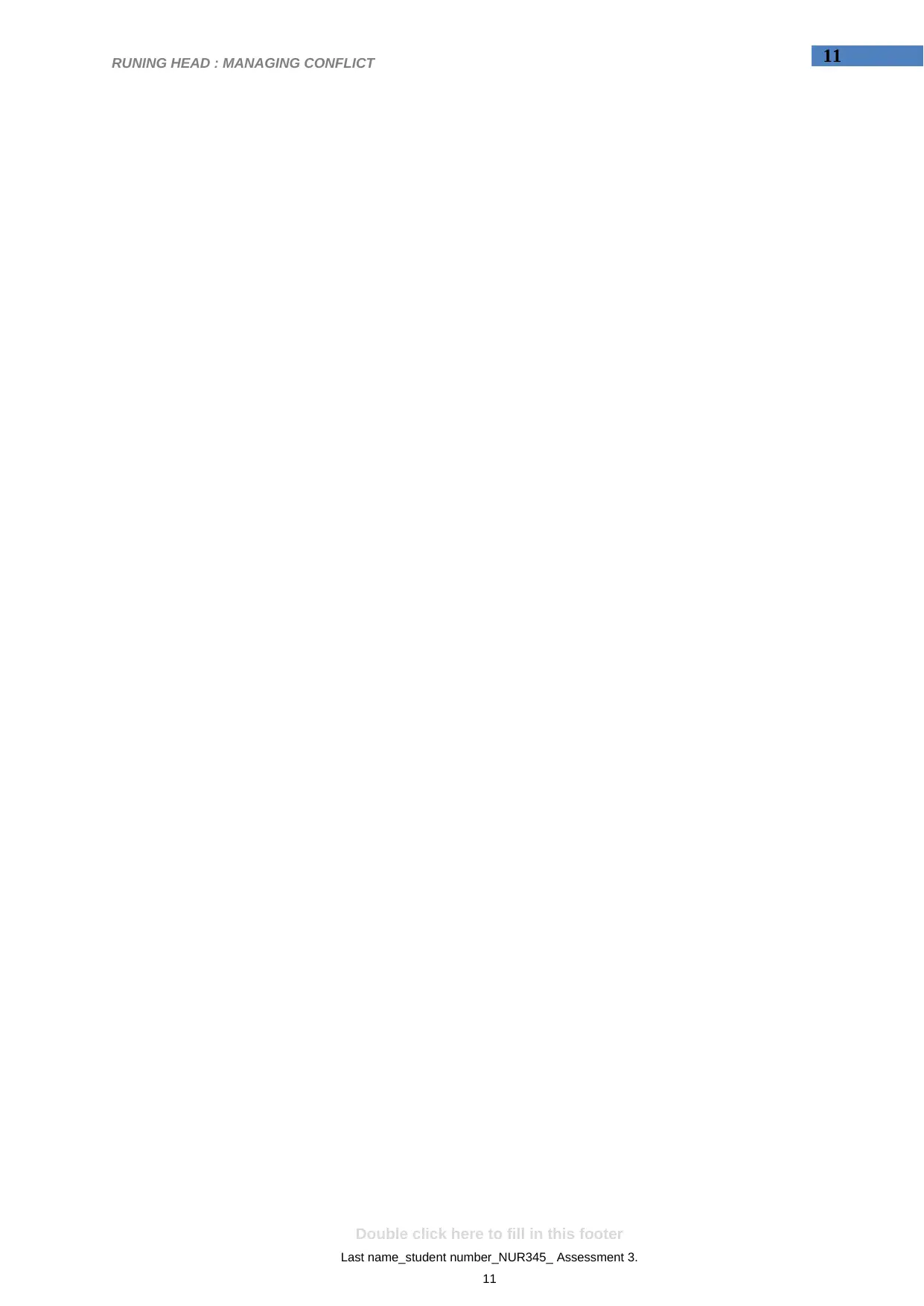
11RUNING HEAD : MANAGING CONFLICT
Double click here to fill in this footer
Last name_student number_NUR345_ Assessment 3.
11
Double click here to fill in this footer
Last name_student number_NUR345_ Assessment 3.
11

12RUNING HEAD : MANAGING CONFLICT
Double click here to fill in this footer
Last name_student number_NUR345_ Assessment 3.
12
Double click here to fill in this footer
Last name_student number_NUR345_ Assessment 3.
12
1 out of 13
Related Documents
Your All-in-One AI-Powered Toolkit for Academic Success.
+13062052269
info@desklib.com
Available 24*7 on WhatsApp / Email
![[object Object]](/_next/static/media/star-bottom.7253800d.svg)
Unlock your academic potential
© 2024 | Zucol Services PVT LTD | All rights reserved.





